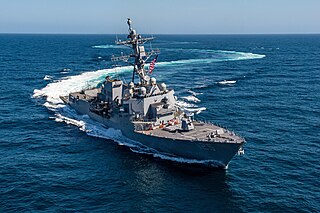
The Arleigh Burke class of guided-missile destroyers (DDGs) is a United States Navy class of destroyer centered around the Aegis Combat System and the SPY-1D multi-function passive electronically scanned array radar. The class is named after Admiral Arleigh Burke, an American destroyer officer in World War II and later Chief of Naval Operations. With an overall length of 505 to 509.5 feet, displacement ranging from 8,300 to 9,700 tons, and weaponry including over 90 missiles, the Arleigh Burke-class destroyers are larger and more heavily armed than many previous classes of guided-missile cruisers.
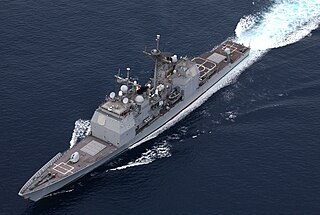
The Aegis Combat System is an American integrated naval weapons system, which uses computers and radars to track and guide weapons to destroy enemy targets. It was developed by the Missile and Surface Radar Division of RCA, and it is now produced by Lockheed Martin.

The Gerald R. Ford-class nuclear-powered aircraft carriers are currently being constructed for the United States Navy, which intends to eventually acquire ten of these ships in order to replace current carriers on a one-for-one basis, starting with the lead ship of her class, Gerald R. Ford (CVN-78), replacing Enterprise (CVN-65), and later the Nimitz-class carriers. The new vessels have a hull similar to the Nimitz class, but they carry technologies since developed with the CVN(X)/CVN-21 program, such as the Electromagnetic Aircraft Launch System (EMALS), as well as other design features intended to improve efficiency and reduce operating costs, including sailing with smaller crews. This class of aircraft carriers is named after former U.S. President Gerald R. Ford. CVN-78 was procured in 2008 and commissioned into service on 22 July 2017. The second ship of the class, John F. Kennedy (CVN-79), is scheduled to enter service in 2025.

The SAMPSON is a multi-function dual-face active electronically scanned array radar produced by BAE Systems Maritime. It is the fire control radar component of the Sea Viper naval air defence system. The Sea Viper system is also known as PAAMS(S) to denote the use of the SAMPSON radar and to distinguish it from the PAAMS system on the Franco-Italian Horizon-class frigate.

An active electronically scanned array (AESA) is a type of phased array antenna, which is a computer-controlled antenna array in which the beam of radio waves can be electronically steered to point in different directions without moving the antenna. In the AESA, each antenna element is connected to a small solid-state transmit/receive module (TRM) under the control of a computer, which performs the functions of a transmitter and/or receiver for the antenna. This contrasts with a passive electronically scanned array (PESA), in which all the antenna elements are connected to a single transmitter and/or receiver through phase shifters under the control of the computer. AESA's main use is in radar, and these are known as active phased array radar (APAR).
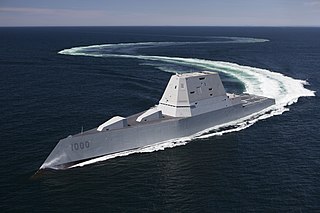
The Zumwalt-class destroyer is a class of three United States Navy guided-missile destroyers designed as multi-mission stealth ships with a focus on land attack. The class was designed with a primary role of naval gunfire support and secondary roles of surface warfare and anti-aircraft warfare. The class design emerged from the DD-21 "land attack destroyer" program as "DD(X)" and was intended to take the role of battleships in meeting a congressional mandate for naval fire support. The ship is designed around its two Advanced Gun Systems (AGS), turrets with 920 round magazines, and unique Long Range Land Attack Projectile (LRLAP) ammunition. LRLAP procurement was canceled, rendering the guns unusable, so the Navy re-purposed the ships for surface warfare. Starting in 2023, the Navy will remove the AGS from the ships and replace them with hypersonic missiles.

The AN/SLQ-32 is a shipboard electronic warfare suite built by the Raytheon Company of Goleta, California and The Hughes Aircraft Company. It is currently the primary electronic warfare system in use by U.S. Navy ships. Its operators commonly refer to it as the "Slick-32".

The AN/APQ-181 is an all-weather, low probability of intercept (LPI) phased array radar system designed by Hughes Aircraft for the U.S. Air Force B-2A Spirit bomber aircraft. The system was developed in the mid-1980s and entered service in 1993. The APQ-181 provides a number of precision targeting modes, and also supports terrain-following radar and terrain avoidance. The radar operates in the Ku band. The original design uses a TWT-based transmitter with a 2-dimensional passive electronically scanned array (PESA) antenna.
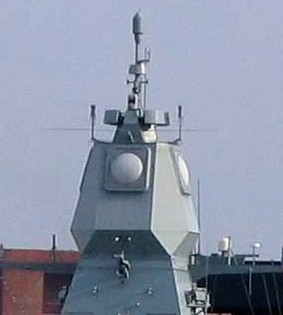
Active Phased Array Radar (APAR) is a shipborne active electronically scanned array multifunction 3D radar (MFR) developed and manufactured by Thales Nederland. The radar receiver modules are developed and built in the US by the Sanmina Corporation.
The Ship Self-Defense System (SSDS) is a combat system specifically designed for anti-air defense of aircraft carriers, and most other non-Aegis United States Navy combat ships. It coordinates several existing shipboard systems. Multi-sensor integration, parallel processing and the coordination of hard and soft kill countermeasure capabilities are key components of the SSDS. Responses to airborne threats are based on automated or man-in-the-loop engagement doctrine.

The Hughes SCANFAR was the first phased array radar system to be deployed by the US Navy, installed on the USS Long Beach (CGN-9) and USS Enterprise (CVN-65). It consisted of two search radars, the AN/SPS-32 and the AN/SPS-33. In 1982, the system was removed from Long Beach, and was replaced by the AN/SPS-48 during a comprehensive overhaul. Aboard the Long Beach, the system used AN/SPG-55 radars for missile guidance.

The AN/SPS-48 is a US naval electronically scanned array, air search three-dimensional radar system manufactured by ITT Exelis and deployed in the 1960s as the primary air search sensor for anti-aircraft warships. The deployment of the AN/SPY-1 and the end of the Cold War led to the decommissioning of many such ships, and many of these vessel's AN/SPS-48 sets were reused on aircraft carriers and amphibious ships where it is used to direct targets for air defense systems such as the Sea Sparrow and RIM-116 SAM missiles. Existing sets are being modernized under the ROAR program to AN/SPS-48G standard for better reliability and usability.

The AN/SPS-49 is a United States Navy two-dimensional, long range air search radar built by Raytheon that can provide contact bearing and range. It is a primary air-search radar for numerous ships in the U.S. fleet and in Spain, Poland, Taiwan aboard Oliver Hazard Perry-class frigates, Canada on its Halifax-class frigate and New Zealand on its Anzac-class frigates. It formerly served in a complementary role aboard Aegis cruisers with the AN/SPY-1 but the systems are currently being removed during routine upgrade with no replacement.
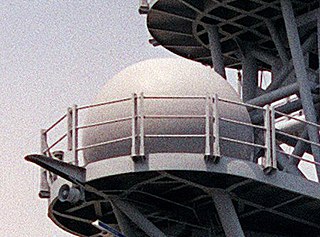
AN/SPQ-9A is a United States Navy multi-purpose surface search and fire control radar used with the Mk-86 gun fire-control system. It is a two dimensional surface-search radar, meaning it provides only range and bearing but not elevation. It is intended primarily to detect and track targets at sea level, on the surface of the water for either gun fire engagement or navigation. It can however, also detect and track low altitude air targets.
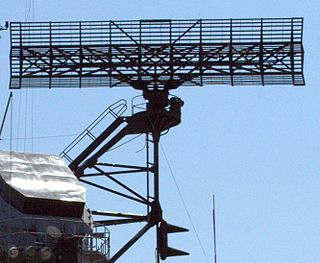
The AN/SPS-43 was a long-range air-search United States Navy radar system introduced in March 1961 that had a range of 500+ km. This radar could provide bearing and distance information, but no altitude information. The small-ship antenna (AN/SPS-29) looked like a bedspring. Larger ships used the 12.8 m wide AN/SPS-37 antenna - about twice as wide and half the height of the SPS-29 antenna - and designed with a much narrower beam. Targets were much more accurately displayed when using the -37 antenna. The -43 operated at VHF frequency - somewhat unusual for any radar - mostly in the bandwidth of television channel 13. The main difference to the SPS-37 was the greatly improved ECCM performance, as the AN/SPS-43 could jump between 20 different frequencies to frustrate jamming attempts. A sea-skimming missile could be detected at a range distance of 30 km, a large high-flying aircraft at 500 km.

The AN/SPY-6 is an active electronically scanned array 3D radar under development for the United States Navy (USN). It will provide integrated air and missile defense for Flight III Arleigh Burke-class destroyers. Variants are under development for retrofitting Flight IIA Arleigh Burkes and for installation aboard Constellation-class frigates, Gerald R. Ford-class aircraft carriers, America-class amphibious assault ships, and San Antonio-class amphibious transport docks.

The AN/SPY-1 is a United States Navy passive electronically scanned array (PESA) 3D radar system manufactured by Lockheed Martin, and is a key component of the Aegis Combat System. The system is computer controlled and uses four complementary antennas to provide 360-degree coverage. The system was first installed in 1973 on USS Norton Sound and entered active service in 1983 as the SPY-1A on USS Ticonderoga. The -1A was installed on ships up to CG-58, with the -1B upgrade first installed on USS Princeton in 1986. The upgraded -1B(V) was retrofitted to existing ships from CG-59 up to the last, USS Port Royal.

EMPAR is a rotating C band multifunction passive electronically scanned array radar that reached IOC in 2006 and was initially built by Selex ES. It is designed to be the principal radar system aboard naval vessels of medium and large sizes. The radar offers full volumetric search coverage, low altitude and surface search, the tracking of multiple targets, and the capability to uplink information for missile guidance.

Selex RAN-40L is a naval 3D L band search radar developed by Leonardo. The radar is used for long range maritime air surveillance and early warning. The radar uses a fully solid state active phased array antenna and capable of tracking and detecting air targets like aircraft or drones up to 400 km away. RAN-40L is based on existing land based 3D RAT-31DL radar which is a system widely used by NATO Countries for long air surveillance.


















